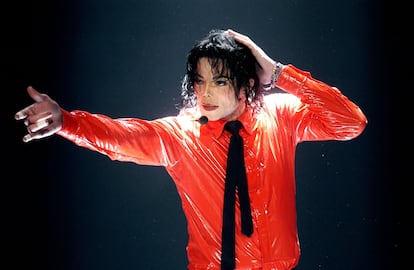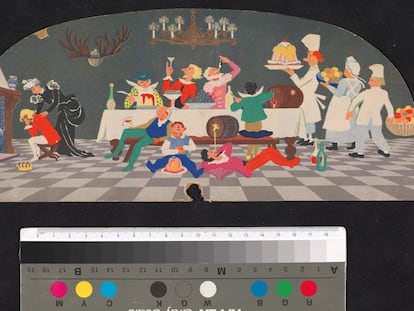The tyranny of kids with cell phones: How infantilization has invaded mass culture
As the lines that separate target audiences by age become increasingly vague, the influence of children on the shape of the cultural products that adults consume keeps growing

Whoever spends some time in the company of children of around 11 years of age (as the author of this article does every morning) will notice that just about anything can be a distraction, an excuse for them to make a racket. Countless signs that would go unnoticed by an adult — some random gesture, an unfortunate word, a bird’s tweet — can be a reference to whatever trend they may be following online. Their world is a never-ending TikTok video.
Many authors in the field of neuroscience, like Francesc Xabier Altarriba, believe that the early stages of adolescence are characterized by a certain “excess of mimesis.” For his part, in his essay El hombre transparente [The Transparent Man], mathematician and writer Javier Moreno explains the viral nature of the internet through René Girard’s mimetic theory: desires are contagious between individuals. The connection is clear — children and teenagers are naturally predisposed to spread and amplify the viral phenomena they see online, be it a popular dance or a harmful challenge.
This tremendous capacity of child users to circulate content on social media has not gone unnoticed by brands, producers or artists. The result is that, either deliberately or due to the momentum of the metrics, the preferences of those children who view, share and spread content much faster than any other age group, could be influencing the shape of cultural products that adults consume, such as television shows, songs and even contemporary art.
The phenomenon has two sides and consequences that are difficult to measure: on one hand, children are exposed to contents that were created for adults, becoming prematurely familiar with their codes; on the other, commercial works allegedly aimed at adults have become filled with nods for the children that are watching, something that brings to mind the “infantilization of society” that philosopher Simon May warns about in his essay The Power of Cute.
A world of children behaving like adults
According to the World Health Organization, “early adolescence” is the stage of life between the ages of 10 and 13. For many, including their parents and teachers, they are still children. Yes, but they are children who have had their own smartphone for years at that age. Magdalena Munuera, a teacher from San Javier, Murcia (Spain), explains the consequences of this: “That is a time bomb, because they don’t know how to handle it. Children don’t use [cellphones] to make calls or send messages; the first thing they do is download apps like TikTok and Instagram.”
Although social networks like Instagram and, particularly, TikTok (where account blocking is common) insist on the effectiveness of the verification mechanisms that prevent registration or limit functions to those under 13 years of age, many children manage to bypass them. Other platforms, like Snapchat, do not even offer those barriers. “They use them to their hearts content,” explains Munuera. “We, the teachers, know this because they themselves tell us: they talk to strangers, listen to adult songs, watch reality shows… All of which makes us think that most of them use their phones without any parental control.”

Beatriz Gimenez de Ory, a high school teacher and winner of the Spanish National Children’s and Youth Literature Award, is also concerned. “Both children and teenagers are extraordinarily vulnerable to those viral phenomena that exalt the banal and propagate attitudes of sexism, consumerism or political radicalization.” The author maintains that the purpose of literature should never be to indoctrinate, educate or satisfy the politically correct demands of publishers and schools. At the same time, she is aware of the role that certain readings play in the lives of many children and teenagers: “Some use fiction to integrate into a group and build a social identity, while others find themselves in books, through similarities with the characters or imitable models of behavior.”
Contents for all ages
Phenomena that attract both children and adults alike have existed for decades. From Michael Jackson to The Simpsons, Adventure Time and much more, the entertainment industry has been producing stars and narratives that are balanced and include something for everyone, regardless of age. However, never before have adult productions displaced or replaced age-specific content. “Some are so hooked on their phone,” says Munuera, “that they no longer have time to read, play with their friends or watch children’s shows.”
In 2019, Martin Scorsese stated that Marvel movies are “not cinema,” angering a large part of the fans of the studio. The director of Taxi Driver compares superhero movies with amusement parks in which he finds nothing interesting. He might think the same about many of today’s television shows. Diana Aller, screenwriter and critic, explains why: “They compete to retain viewers, who are leaving en masse to consume on platforms. There is a kind of downward standardization where quantity is favored over quality, which produces very uniform, vulgar products. There is fear of innovating and, when they do it, they are clumsy movements that imitate the internet and seek online transversality.”

Together with television, which served as a showcase for all trends, contemporary art was the most up-to-date and agile expression of the “spirit of the times” throughout the entire 20th century. Thus, in infantilized times, we cannot help but wonder if childish art is also being produced. “The success of toy art, those sorts of trinkets that are spreading like wildfire and look like art, but at the same time can be placed on a shelf, shows that it is,” says Javier Castro, curator and gallery owner.
“But the question doesn’t have so much to do with the size of the objects as with the representation of childhood. Since the 1920s, artists like Hans Bellmer with his dolls, or Duchamp with his mannequins, have explored their most sinister and deepest part. It is a tradition that is continued by the Chapman Brothers or Paul McCarthy. But the works of the most recent artists, who tend to target the Asian market, are radically different and evoke the Japanese kawaii style, which would be the cute and nice, against the unfathomable background of childhood. They offer a flat image of a life stage that is the cradle of all fears, a wild jungle that we have all known in schools, where the worst was possible every day,” adds Castro.

One can find simplifications and approaches such as those mentioned by Castro in the work of successful artists like Yoshitomo Nara, Takashi Murakami or the very famous Jeff Koons. In any case, the curator and thinker does give them some credit, concluding: “I see it as a paradox, because it is a light and friendly type of art that horrifies me, but I also think that it reflects very well the nothingness in which we move.”
Peter Pan gets serious
Childhood as we know it is a product of Victorian England. There, the first limits to child labor were established, toy factories appeared and dozens of writers like Lewis Carroll, JM Barrie, Charles Kingsley and Edward Lear directed part of their efforts towards the publication of small books that parents could read to their children out loud. Childhood was then a dam that prevented the obligations and miseries of the adult world from reaching minors too soon.
Currently, virality is the most prized value; through it, the world of children is reaching — even replacing — that of adults. Peter Pan left his parents’ house when he heard them making plans for his future. His refusal to grow up and his extravagance were a protest against the rigidity of the society into which he was born. 120 years later, things would not have been so easy for him. Today, Peter would have to find a different strategy to rebel against the dominance of the big tech companies, and he surely would miss out on a lot of fun TikTok dances.
Sign up for our weekly newsletter to get more English-language news coverage from EL PAÍS USA Edition
Tu suscripción se está usando en otro dispositivo
¿Quieres añadir otro usuario a tu suscripción?
Si continúas leyendo en este dispositivo, no se podrá leer en el otro.
FlechaTu suscripción se está usando en otro dispositivo y solo puedes acceder a EL PAÍS desde un dispositivo a la vez.
Si quieres compartir tu cuenta, cambia tu suscripción a la modalidad Premium, así podrás añadir otro usuario. Cada uno accederá con su propia cuenta de email, lo que os permitirá personalizar vuestra experiencia en EL PAÍS.
¿Tienes una suscripción de empresa? Accede aquí para contratar más cuentas.
En el caso de no saber quién está usando tu cuenta, te recomendamos cambiar tu contraseña aquí.
Si decides continuar compartiendo tu cuenta, este mensaje se mostrará en tu dispositivo y en el de la otra persona que está usando tu cuenta de forma indefinida, afectando a tu experiencia de lectura. Puedes consultar aquí los términos y condiciones de la suscripción digital.
More information
Archived In
Últimas noticias
Maduro counterattacks Trump with rhetoric and announces downing of nine drug trafficking aircraft
‘Ecce Homo’: The miraculous disaster that made a small Spanish town famous
Return to sex testing at the Olympics: IOC edges closer to banning transgender women
Trump escalates conflict with Venezuela with the start of covert operations
Most viewed
- Sinaloa Cartel war is taking its toll on Los Chapitos
- Oona Chaplin: ‘I told James Cameron that I was living in a treehouse and starting a permaculture project with a friend’
- Reinhard Genzel, Nobel laureate in physics: ‘One-minute videos will never give you the truth’
- Why the price of coffee has skyrocketed: from Brazilian plantations to specialty coffee houses
- Silver prices are going crazy: This is what’s fueling the rally










































